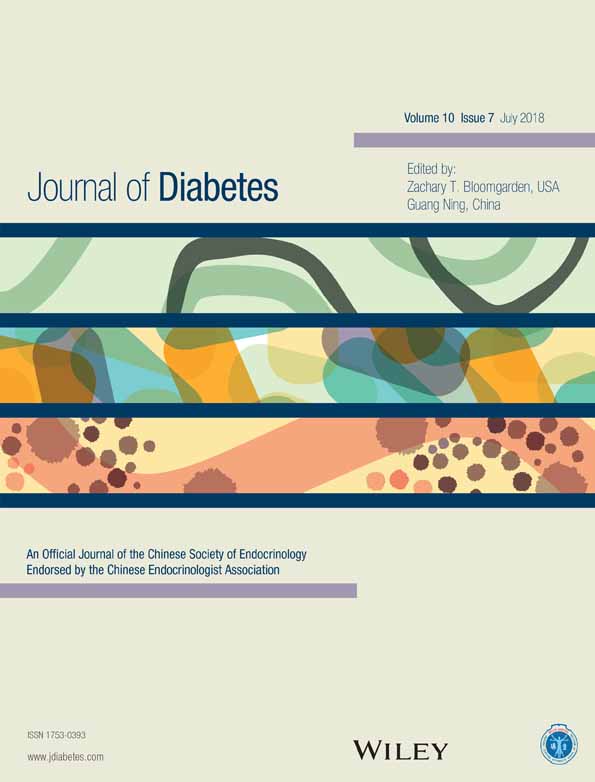Dapagliflozin as add-on therapy in Asian patients with type 2 diabetes inadequately controlled on insulin with or without oral antihyperglycemic drugs: A randomized controlled trial†
达格列净联合胰岛素治疗无论是否使用口服降糖药均血糖控制不佳的亚洲2型糖尿病患者:一项随机对照试验
Abstract
enBackground
This 24-week Phase 3 double-blind placebo-controlled study assessed the safety and efficacy of dapagliflozin as add-on to insulin, with or without oral antihyperglycemic drugs (OADs), in Asian patients with inadequately controlled type 2 diabetes mellitus.
Methods
Adult patients with HbA1c between ≥7.5% and ≤10.5%, body mass index ≤45 kg/m2, and on insulin doses ≥20 IU daily were randomized to dapagliflozin 10 mg (n = 139) or placebo (n = 133) to assess 24-week changes in HbA1c (primary outcome), fasting plasma glucose (FPG), body weight, total daily dose of insulin (TDDI), and seated systolic blood pressure (SeSBP; exploratory outcome).
Results
Baseline characteristics were similar in both groups. At Week 24, compared with placebo, dapagliflozin significantly improved HbA1c (mean [95% confidence interval] 0.03% [−0.11, 0.17] for placebo vs −0.87% [−1.00, −0.74] for dapagliflozin; between-group difference − 0.90% [−1.09, −0.71], P < 0.0001]), FPG, body weight, TDDI, and SeSBP. The incidence of adverse events (AEs) in the dapagliflozin and placebo groups was 80.5% and 71.2%, respectively, with few patients discontinuing due to AEs (dapagliflozin, 2.2%; placebo, 4.2%). The occurrence of hypoglycemia was similar in the dapagliflozin and placebo groups (23.7% and 22.6%, respectively; no major events). The frequency of urinary tract and genital infections was low; no deaths were reported.
Conclusions
Dapagliflozin as add-on to insulin, with or without OADs, significantly improved glycemic control and reduced body weight and blood pressure in Asian patients. Dapagliflozin was well tolerated, with a similar frequency of hypoglycemia in both groups. These results support the use of dapagliflozin as add-on to insulin, with or without OADs, in this population.
摘要
zh背景
本研究为一项双盲、随机分组、安慰剂对照的3期临床研究, 为期24周, 旨在评估在血糖控制不佳的亚洲2型糖尿病患者中, 达格列净联合胰岛素, 加用或不加用口服降糖药治疗的有效性和安全性。
方法
入组成年患者的糖化血红蛋白(HbA1c)≥7.5%且≤ 10.5%, 身体质量指数≤ 45 kg/m2, 且使用胰岛素剂量≥ 20 IU/天, 患者被随机分为达格列净10 mg组(n = 139)或安慰剂组(n = 133), 研究终点为治疗24周后HbA1c较基线水平的变化, 空腹血糖(FPG)、体重和胰岛素每日总剂量(total daily dose of insulin, TDDI)及坐式收缩压(seated systolic blood pressure, SeSBP)与基线相比的变化。
结果
两组间研究人群的基线特征无差别。治疗24周后, 相较安慰剂组, 达格列净组患者的HbA1c(安慰剂组的平均值 [95%置信区间]0.03% [-0.11, 0.17], 达格列净组为-0.87% [-1.00, -0.74];组间差异-0.90% [-1.09, -0.71], P < 0.0001)、FPG、体重、TDDI及SeSBP都有显著改善。研究期间, 达格列净组和安慰剂组的副作用总体发生率分别为80.5%和71.2%;较少患者因不良事件而退出研究(达格列净组为2.2%, 安慰剂组为4.2%);低血糖发生率两组相似, 达格列净组和安慰剂组分别为23.7%和22.6%, 无严重低血糖事件发生。尿路感染和生殖系统感染发生率相对较低, 无死亡病例报道。
结论
在亚洲患者中进行达格列净联合胰岛素治疗, 加用或不加用口服降糖药治疗可显著改善患者血糖, 降低体重和血压。达格列净的耐受性良好, 与安慰剂组低血糖发生率相似。本研究支持在亚洲人群中进行达格列净联合胰岛素加用或不加用口服降糖药治疗治疗。




